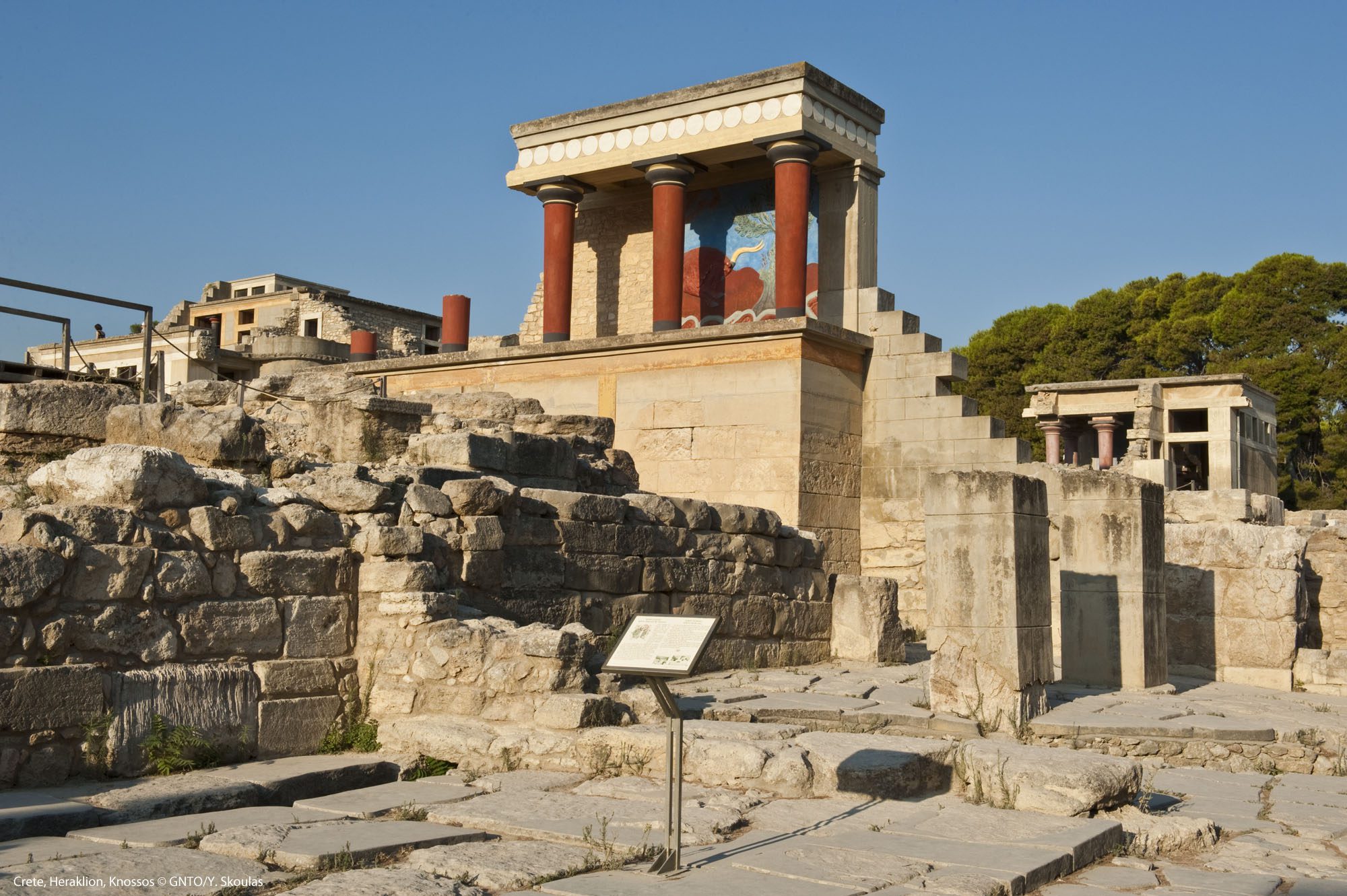Last updated on November 10th, 2024
Featured image: The ancient archaeological site of Knossos Palace, near Heraklion, Crete | Photo by J. Skoulas from the Greek National Tourism Organization
Myth, history and legend make a gripping read
By Sally Jane Smith, Book club co-host
It was in Crete I made the kind of rookie travel mistake I thought I’d put behind me long ago: guesstimating the time needed to get from A to B based on a quick glance at a map. I should have known better. I’d read Kate Forsyth’s The Crimson Thread in the run-up to my 2023 trip, and if ever there’s a novel that conveys the difficulty of crossing Crete’s majestic Lefka Ori (White Mountains), it’s this one.
For Forsyth’s characters, this mountain range means mortal danger, confrontation with deep-rooted fear, and a desperate race against time to rendezvous with a boat to safety. For me, it meant a scramble to rejig my itinerary and the sting of forfeiting my payment for a night’s accommodation. Because of course you can’t cut straight across the island from Agios Nikolaos to Loutro. And the public buses won’t get you all the way to Chora Sfakion in time for the last ferry – not outside of the tourist season, anyway.
The author’s sense of place is masterful. When her protagonist landed in Heraklion, I could tell immediately he was walking the same street I strolled, that he paused to gaze at the same landmarks, that he felt the same awe I experienced when engaging with the landscape and its stories.
Read More: Sign up for our book club newsletter here
Perhaps its Forsyth’s own fascination with stories that allows her to weave the legends of millennia past with oral history and 20-century resistance fighters’ memoirs. The result? A multi-layered tale that is, on one level, an easy-to-read wartime romance and, on another, a delicate embroidery of mythological references and symbolism. And the thread that runs through it all is the ancient legend of the Minotaur and the labyrinth.
The testosterone-laden account of this brutal monster, heroically slaughtered by Theseus, has been told and retold for thousands of years. But that’s not the whole story, not by a very long shot. For women, the betrayal faced by Ariadne can feel more brutal than the tortured Minotaur’s thirst for blood. The introduction of this dynamic into the trope of the love triangle makes The Crimson Thread both more subtle and more shocking – and completely relevant to the culture of toxic masculinity that still thrives in many circles today.
“The Minotaur, a half-man, half-bull monster, is imprisoned in a labyrinth built by King Minos of Crete. King Minos is a powerful and tyrannical ruler, and the father of Ariadne, a beautiful princess who falls in love with Theseus, the young prince of Athens who embarks on a dangerous quest to slay the Minotaur.”
Read more on the Knossos Palace website here
About the author
Dr Kate Forsyth is an award-winning author, poet, and storyteller. The Crimson Thread is a reimagining of ‘The Minotaur in the Labyrinth’ myth set in Crete during the Nazi invasion and occupation of World War II.
On her website, Forsyth writes: “I don’t know why this ancient myth struck me so forcibly. Perhaps because it was the only story in the book where a girl has an instrumental role to play. It is not the hero Theseus who solves the puzzle of how to escape from the labyrinth, it is Ariadne. He is simply doing her bidding.
The minotaur in the labyrinth is a very old tale, older even than ancient Greece, because its roots lie in the bull-dancing culture of the Minoan civilisation that existed in Crete from around 2000 BCE. The ruined palace of Knossos – which is where my story is centred – has evidence of this in its frescoes and artefacts.”
Other historical novels include Beauty in Thorns, a reimagining of ‘Sleeping Beauty’ told in the voices of four women of the Pre-Raphaelite circle of artists and poets; The Wild Girl, the story of the forbidden romance behind the Grimm brothers’ fairy tales which was named Most Memorable Love Story of 2013; and Bitter Greens, a retelling of ‘Rapunzel’ which won the 2015 American Library Association award for Best Historical Fiction.
Kate has a Doctorate of Creative Arts in fairy tale studies, and is also an accredited master storyteller with the Australian Guild of Storytellers. She has taught writing retreats in Australia, Fiji, Greece, and the United Kingdom.
Book Club Discussion Questions: The Crimson Thread
The story is set in Crete. Have you ever travelled there? Did the setting feel familiar to you from your own travels?
1. The characters in the book, especially Alenka and her grandmother, wear talismans including the mati or evil eye, red-and-white thread martis bracelets, coins, and Christian crosses. Do you wear an item for luck, protection, or because it symbolises something significant to you? Is it from your own country or something you collected on your travels?
2. What did you think of Axel, Alenka’s little brother, at the beginning of the story? Did you feel any sympathy for him? What about as the novel progressed? What do you think drove his actions?
3. How did the way Jack engaged with the landscape and people of Crete contrast with Teddy’s relationship with the Cretans and their island?
4. The core of the novel is set at the archaeological site of Knossos and the nearby Villa Ariadne, which was a key site for some of the most daring exploits in wartime Crete. Did you know that some of the characters were real-life resistance fighters – Patrick Leigh-Fermor, George Psychoundakis and others – who went on to write their memoirs of these events? How do you think this might have affected the author’s writing of the novel?
5. Alenka thought that all of Australia was a hot, dry, red desert – until Teddy told her he lived in a snowy, mountainous region. Have you ever been surprised by the landscape and climate of a country you visited?
6. Teddy and Jack both have real fears born of past trauma: Teddy is afraid of heights; Jack is scared of snakes. Do you have fears – rational or irrational – that you need to confront on your journeys?
7. The Battle of Crete was one of the largest parachute assaults in history, and the evacuation of thousands of Allied soldiers from Crete’s southern coast was a significant operation. Had you heard of these World War II events before reading this book? Why do you think some battles and wars are more prominent in public awareness than others?
8. Alenka uses dittany, a wild herb endemic to Crete, which has been known to have healing properties since the time of Aristotle and before. Have you ever used local herbal remedies on your travels? Did they work?
9. The author weaves references to Greek mythology – some open, some subtle – throughout the story. The legend that emerges most often, and inspires the novel’s title, is the story of how Ariadne enables Theseus to escape the Minotaur’s lair, and then her horrendous mistreatment at the hands of this ‘hero’. As you read, did you pick up on any glimpses of harmful gender relations that ring true for our society today?
10. Jack knows Teddy is a terrible example of toxic masculinity, and yet he remains grateful for his friendship. Why do you think they share such a tight bond?
11. After a succession of terrible events, Alenka is almost broken by grief. Eventually, she finds the strength to carry on. Do you think it’s true that grief is healed by time?
12. There is a fascinating Author’s Note at the end of the book, throwing light on many of the themes of the story. Do you generally read afterwords and epilogues? If you read this one, what was your most interesting takeaway?
13. Did you learn anything about Crete that surprised you?
14. Did the book make you want to travel to Crete?
More on Greece
Lessons from the Blue Zones: Why Blue Zones Matter to Women in a World Obsessed with Living Longer
While we may not be able to travel to all the world’s Blue Zones, they remind us to move, eat well, connect socially and live with purpose.
15 Stunning Train Trips to Inspire Your Travels in 2025
These train trips across Europe, Asia, Africa and Canada remind us that the journey can be more memorable than the destination.
Riding Solo Over 50: How Cycling Opened up a Whole New World For Me
For women over 50 who want to stay active while travelling, group cycling trips offer a way to make connections while seeing the world.








0 Comments
We always strive to use real photos from our own adventures, provided by the guest writer or from our personal travels. However, in some cases, due to photo quality, we must use stock photography. If you have any questions about the photography please let us know.
Disclaimer: We are so happy that you are checking out this page right now! We only recommend things that are suggested by our community, or through our own experience, that we believe will be helpful and practical for you. Some of our pages contain links, which means we’re part of an affiliate program for the product being mentioned. Should you decide to purchase a product using a link from on our site, JourneyWoman may earn a small commission from the retailer, which helps us maintain our beautiful website. JourneyWoman is an Amazon Associate and earns from qualifying purchases. Thank you!
We want to hear what you think about this article, and we welcome any updates or changes to improve it. You can comment below, or send an email to us at [email protected].